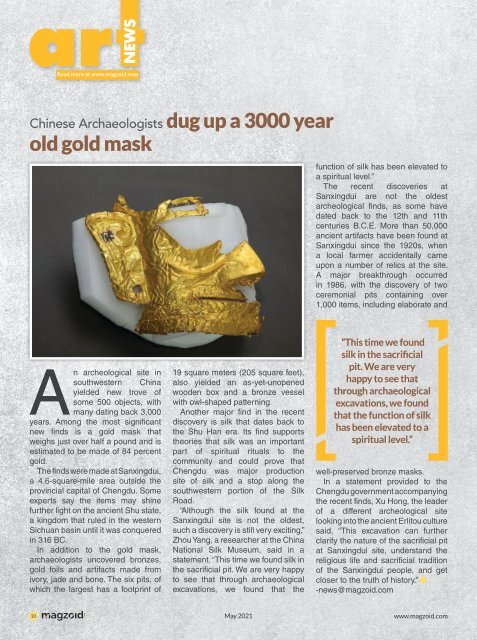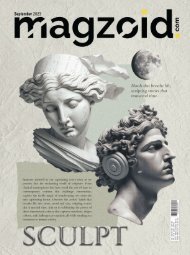Magzoid Magazine - Leading Art Magazine of MENA | May 2021
MAGZOID is one of the Leading Premium Art Magazine of the MENA region which has it’s presence Online as well as on the Print Media. Leading Art Magazine for all the Art News, Art Exhibitions, Artist Feature, Art Knowledge, History in Arts, Recent findings in Art world, Global Art Facts and many more.
MAGZOID is one of the Leading Premium Art Magazine of the MENA region which has it’s presence Online as well as on the Print Media. Leading Art Magazine for all the Art News, Art Exhibitions, Artist Feature, Art Knowledge, History in Arts, Recent findings in Art world, Global Art Facts and many more.
Create successful ePaper yourself
Turn your PDF publications into a flip-book with our unique Google optimized e-Paper software.
Read more at www.magzoid.com<br />
Chinese Archaeologists dug up a 3000 year<br />
old gold mask<br />
function <strong>of</strong> silk has been elevated to<br />
a spiritual level.”<br />
The recent discoveries at<br />
Sanxingdui are not the oldest<br />
archeological finds, as some have<br />
dated back to the 12th and 11th<br />
centuries B.C.E. More than 50,000<br />
ancient artifacts have been found at<br />
Sanxingdui since the 1920s, when<br />
a local farmer accidentally came<br />
upon a number <strong>of</strong> relics at the site.<br />
A major breakthrough occurred<br />
in 1986, with the discovery <strong>of</strong> two<br />
ceremonial pits containing over<br />
1,000 items, including elaborate and<br />
An archeological site in<br />
southwestern China<br />
yielded new trove <strong>of</strong><br />
some 500 objects, with<br />
many dating back 3,000<br />
years. Among the most significant<br />
new finds is a gold mask that<br />
weighs just over half a pound and is<br />
estimated to be made <strong>of</strong> 84 percent<br />
gold.<br />
The finds were made at Sanxingdui,<br />
a 4.6-square-mile area outside the<br />
provincial capital <strong>of</strong> Chengdu. Some<br />
experts say the items may shine<br />
further light on the ancient Shu state,<br />
a kingdom that ruled in the western<br />
Sichuan basin until it was conquered<br />
in 316 BC.<br />
In addition to the gold mask,<br />
archaeologists uncovered bronzes,<br />
gold foils and artifacts made from<br />
ivory, jade and bone. The six pits, <strong>of</strong><br />
which the largest has a footprint <strong>of</strong><br />
19 square meters (205 square feet),<br />
also yielded an as-yet-unopened<br />
wooden box and a bronze vessel<br />
with owl-shaped patterning.<br />
Another major find in the recent<br />
discovery is silk that dates back to<br />
the Shu Han era. Its find supports<br />
theories that silk was an important<br />
part <strong>of</strong> spiritual rituals to the<br />
community and could prove that<br />
Chengdu was major production<br />
site <strong>of</strong> silk and a stop along the<br />
southwestern portion <strong>of</strong> the Silk<br />
Road.<br />
“Although the silk found at the<br />
Sanxingdui site is not the oldest,<br />
such a discovery is still very exciting,”<br />
Zhou Yang, a researcher at the China<br />
National Silk Museum, said in a<br />
statement. “This time we found silk in<br />
the sacrificial pit. We are very happy<br />
to see that through archaeological<br />
excavations, we found that the<br />
“This time we found<br />
silk in the sacrificial<br />
pit. We are very<br />
happy to see that<br />
through archaeological<br />
excavations, we found<br />
that the function <strong>of</strong> silk<br />
has been elevated to a<br />
spiritual level.”<br />
well-preserved bronze masks.<br />
In a statement provided to the<br />
Chengdu government accompanying<br />
the recent finds, Xu Hong, the leader<br />
<strong>of</strong> a different archeological site<br />
looking into the ancient Erlitou culture<br />
said, “This excavation can further<br />
clarify the nature <strong>of</strong> the sacrificial pit<br />
at Sanxingdui site, understand the<br />
religious life and sacrificial tradition<br />
<strong>of</strong> the Sanxingdui people, and get<br />
closer to the truth <strong>of</strong> history.”<br />
-news@magzoid.com<br />
10 <strong>May</strong> <strong>2021</strong><br />
www.magzoid.com

















